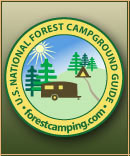Forest Information
The Columbia River Gorge National Scenic Area is east of
Portland, Oregon and Vancouver, Washington in a canyon along the
Columbia River in Oregon and Washington. It is comprised of
295,000 acres with four campgrounds, two of which meet the
selection criteria.
When Lewis and Clark, along with the Corps of Discovery, first
saw the Columbia River it was untamed and free-flowing. Clark
described the narrows near the Dalles as "agitated gut swelling,
boiling & whorling in every direction." Today, that stretch of
wild water is gone, tamed by massive dams. And, the Columbia
River moves through the "Gorge" with a deceptive
passive appearance past the Dalles and on to the Pacific Ocean.
Still a spectacular river canyon, the "Gorge" is 80 miles long
with walls towering up to 4,000 feet deep. This stretch of the
Columbia River was established by Congress in 1986 as the
Columbia River Gorge National Scenic Area (Gorge). With many of
the wonders Lewis and Clark observed and still present for the
visitor, the Gorge is more than a place of natural wonder. It is
a place for all sorts of recreational activities.
The Gorge offers visitors panoramic viewpoints, waterfalls, back
road exploration, biking, wilderness trails, fishing,
interpretive centers, museums, wineries, wind surfing, kayaking,
historic communities, fishing, camping, and more. While these
activities are enjoyed by thousands of individuals each year,
perhaps the most popular activities enjoyed by visitors are
driving through the Gorge, along Interstate 84 on the Oregon
side, and viewing its glorious waterfalls. State Rt. 14, along
the Washington side of the Gorge, offers visitors the opportunity
to visit several of the quaint historic communities.
People have been discovering the Gorge's waterfalls since Lewis
wrote "We passed several beautiful cascades which fell from a
great height over the stupendous rocks which closes the river on
both sides. . ." The original Columbia River Highway, opened in
1916, was heralded as "one of the greatest engineering feats of the
modern age" and provided the public with easy access to several
more spectacular "cascades." With water falling 620 feet,
Multnomah Falls (the second highest year-round waterfall in the
nation) has long been a must stop. The classic 1925 lodge at the
fall's base hosts a Forest Service visitor center, dining rooms,
banquet facilities, and a gift shop and is also worth a visit.
Although some say they aren't as spectacular as Multnomah Falls,
many visitors also enjoy Bridal Veil, Mist, Wahkeena, and
Fairy falls. Then, there are Horsetail, Ponytail, Oneonta, and
Triple falls. Each of these waterfalls is a gem in itself but
not as easy to reach as Multnomah Falls where you can drive to up
to it. The problem is solved with a network of
maintained trails. Trail number 438 starts at Horsetail Falls
and winds around to Ponytail, Oneonta, and Triple falls. Trails
number 415, 420, and 441 provide access to the other waterfalls
mentioned. Be sure to wear sturdy shoes and bring your camera.
The trail system in the Gorge provides visitors with access to
more than just waterfalls. There are dramatic vistas, lush old-
growth conifer forests, and meadows full of magnificent
wildflowers to discover. Hikers can find evidence, such as the
remnants of fish wheels, petroglyphys and pictographs, of the
Native people's presence in the Gorge. Gorge Trail #400 is
one of several courses hikers and mountain bikers find a
challenge while enjoying the scenery. Perhaps the best feature
of the numerous trails that crisscross the Gorge is that they
provide visitors with an up-close-and-personal view of the area's
amazing geology.
Built by eons of ash, lava, and mud flows produced by the fiery
volcanoes of the Cascade Mountains, the Columbia River cuts a
deep corridor through all those layers. Then, about 15,000 years
ago and near the end of the last Ice Age, a gigantic flood swept
down the river corridor and scoured cliffs. The massive wall of
water, estimated to have been 1,200 feet tall, left tributary
streams hanging high over the river and produced one of the
world's greatest concentrations of waterfalls. And, the shaping
of the Gorge continues today. Wind, rain, snow, ice, and the
Columbia River itself continue to change the shape and reshape
the Gorge.
The Gorge has two developed campgrounds which can be used as base
camps for exploring the area. Eagle Creek campground is the
oldest of the two. Originally built on the banks of the Columbia
River in 1915, the campground is now located on a hillside above
the River. Secluded sites tucked in lush vegetation, the Eagle
Creek campground is the center of a recreation area that includes
miles of trails and good fishing opportunities. Eagle Creek
campground has a long and interesting history which is recalled
by the design used for the Wyeth campground. With a more open
and spacious feel, Wyeth is better suited to campers in
recreational vehicles. Formerly the location of Civilian
Conservation Corps (CCC) Camp 21, the campground has a quaint
"feel" with CCC-style curbstones and the replication of a Public
Comfort Station structure.
While the campgrounds are a great place to just sit and enjoy the
surroundings, the Gorge offers, besides the waterfalls, much to
do. There is the Vista House at Crown Point State Park, the
Columbia Gorge Discovery Center in The Dalles, Columbia Gorge
Interpretive Center, and of course the Booneville Dam and Visitor
Center, to mention just a few attractions. There is wind surfing
for the adventurous, vineyards for wine drinkers, lots of places
to shop, orchards full of great tasting fruit, and many memories
to make. With so much to do, see, discover, and experience,
the Columbia River Gorge Scenic Area awaits you.
ADDRESSES
SUPERVISOR ADDRESS
902 Wasco St.
Suite 200
Hood River, Oregon 97031
RANGER DISTRICT ADDRESS
Columbia River Gorge National Scenic Area
902 Wasco St.
Suite 200
Hood River, Oregon 97031
541-308-1700
|
